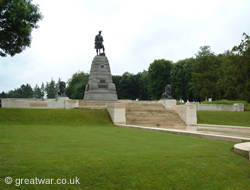Newfoundland Memorial Park, Beaumont Hamel, France
Newfoundland Memorial Park is a site on the Somme battlefield near to Beaumont Hamel. The land was purchased by the Dominion of Newfoundland after the First World War. It was named after the Royal Newfoundland Regiment, which had provided one battalion of 800 men to serve with the British and Commonwealth Armies. It's tragic part in the action of 1 July 1916 is remembered through this memorial park. The site is also a memorial to all the Newfoundlanders who fought in the First World War, most particularly those who have no known grave.
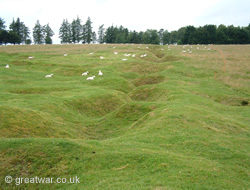
|
The park does, nevertheless, preserve the memory of the men of the many other regiments from the French, British and German Armies who fought and died on this part of the Somme battleground from September 1914 into 1918.
The Newfoundland Memorial Park was opened on 7 June 1925 by Field Marshal Earl Haig. Newfoundland became a province of Canada in 1949. Newfoundland Park is one of only two Canadian National Historic Sites outside Canada. The other National Historic Site is also in France at Vimy Ridge. The landscape architect for the design of the park was R H K Cochius.
- Dedication Stone
- Memorial to the 29th Division
- Caribou Memorial
- Military Cemeteries in the Park
- 51st (Highland) Division Memorial
- Y Ravine - The Leiling Stollen
- The Visitors' Centre
- Location of the Memorial Park
Dedication Stone
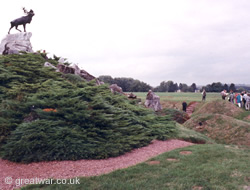
|
At the entrance to the park there is a bronze cast with the following words inscribed on it:
Tread softly here! Go reverently and slow!
Yea, let your soul go down upon its knees,
And with bowed head and heart abased strive hard
To grasp the future gain in this sore loss!
For not one foot of this dank sod but drank
Its surfeit of the blood of gallant men.
Who, for their faith, their hope,—for Life and Liberty,
Here made the sacrifice,—here gave their lives.
And gave right willingly—for you and me.
From this vast altar—pile the souls of men
Sped up to God in countless multitudes:
On this grim cratered ridge they gave their all.
And, giving, won
The peace of Heaven and Immortality.
Our hearts go out to them in boundless gratitude:
If ours—then God's: for His vast charity
All sees, all knows, all comprehends—save bounds.
He has repaid their sacrifice:—and we—?
God help us if we fail to pay our debt
In fullest full and unstintingly!
Memorial to the 29th Division
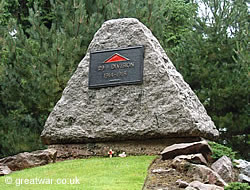
|
On the morning of 1 July 1916, as the Battle of the Somme began, the 29th Division was in action on the British Front Line in the location which is now Newfoundland Memorial Park. The division suffered a high number of casualties as a result of the success of the German defence in this sector. Many were cut down before they got anywhere near the German Front Line. Many were killed and wounded as they moved forward from the rear of the Front Line to follow on in the attack.
The divisional badge was a red triangle.
In Action at Gallipoli, 25 April 1915 - 8 January 1916
The 29th Division was formed up in the United Kingdom between January and March 1915. In mid March it was sent to Egypt, from where it sailed to take part in the Gallipoli Campaign, landing at Cape Helles on 25 April 1915. After 8 months of fighting in the Gallipoli Penninsular the 29th Division left Gallipoli on 7 and 8 January 1916, as part of the secret, silent evacuation of British troops from this fighting front. After a few weeks in Egypt the Division was ordered to move to the Western Front.
29th Division Arrives on the Somme Battlefront, March 1916
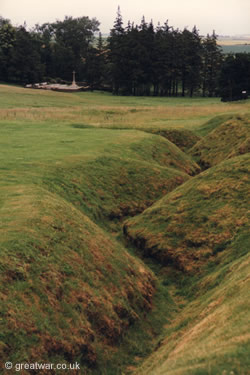
|
Passing through the Mediterranean port of Marseilles the 29th Division arrived in the rear of the Somme battle front from 15 to 29 March 1916. From this time the Division was put into the British Front in the area north of the Ancre River, near to the German-held village of Beaumont Hamel. For the following three months the battalions in the Division spent their time doing tours of trenches and training behind the lines to prepare for the large British offensive against the German position planned for the end of June.
29th Division in the Battle of the Somme, 1 July 1916
Following a 7 day artillery bombardment of the German Front and Rear areas, the battalions of the 29th Division were in position in their Assembly Trenches in the early hours of Saturday 1st July. At 07.20 hours the huge Hawthorn mine was blown on the left of the division's position. The leading battalions in the attack left the British Front Line trench at 07.30 hours.
The Caribou Memorial
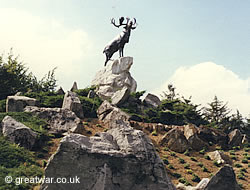
|
The Caribou is one of 5 such memorials on the Western Front which commemorate the location where the 1st Battalion of the Newfoundland Regiment was in action. The caribou is the emblem of the Newfoundland Regiment. The sculptor of the bronze caribou was an Englishman called Basil Gotto.
The Caribou Memorial is situated on the high ground at the western side of the park, behind the British July 1916 Front Line, from where the 1st Battalion the Newfoundland Regiment began it's advance into the attack on that fateful morning. The shrubs around the rocks are native plants from Newfoundland.
At the base of the Caribou there are three bronze panels listing 814 names for the Memorial to the Newfoundlanders Missing. These are Newfoundlanders who died on land and at sea in the First World War and who have no known graves.
The Caribou can be accessed by a path and there is an orientation table giving an overview of the park. From here there is an excellent view of the Memorial Park and across the landscape to Beaumont village and to Thiepval on the high ground of the southern bank of the Ancre River.
5 Caribou Memorials on the Western Front
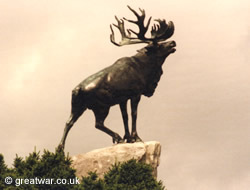
|
- Newfoundland Memorial Park, Somme battlefield near Beaumont Hamel
- Geudecourt (1916), Somme battlefield near Bapaume
- Harelbeke (1918), near Courtrai (Kortrijk)
- Masnières (1918), near Cambrai
- Monchy-le-Preux, near Arras
Military Cemeteries
There are three cemeteries in the memorial park:
Hawthorn Ridge Cemetery No. 2
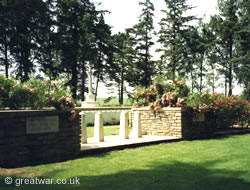
|
51st (Highland) Division Memorial
The memorial commemorates the men of the 51st (Highland) Division which captured the village of Beaumont Hamel on 13 November 1916.
51st (Highland) Division Memorial
Y Ravine - the Leiling Stollen
The German regiment in the line at Beaumont Hamel was the 119 Reserve Infantry Regiment. The regiment had arrived in this sector in late September 1914, at which time it been engaged in a fight with the French Army. In August 1915 the French Army left this sector and the British Army took over. 119 Reserve Infantry Regiment, however, held this part of the German Front Line for 19 months as part of the 26th Reserve Division before the Battle of the Somme began on 1 July 1916.
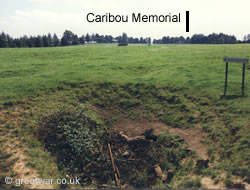
|
The men of the 119 Reserve Infantry Regiment were recruited mainly from a mining area in the German occupied province of Lorraine. As a result of their skills at mining they spent much of their time developing the sector's defences. They dug a number of large bunkers and protective man-made caverns, called “Stollen” or “Feste”, into the chalk landscape around Beaumont Hamel village. South of the village, one of these large bunkers was the Leiling Stollen. It was built into the natural feature of a Y shaped ravine within the area of the German Front Line. The name Leiling was given to the bunker after Hauptmann Leiling, one of the German captains in the regiment and designer of the bunker.
The German Front Line in this part of the sector at Y Ravine was situated at the bottom of a gentle slope. The British Front Line was situated a few hundred metres away on the higher ground of the slope. In spite of the pounding of the German Line by the 7 day British artillery bombardment before the attack on 1 July most of the German soldiers had survived the shelling by sheltering in their protective bunkers. German accounts state that their nerves were frayed by the end of the 7 days, but their casualties were relatively light. When the British artillery fire was lifted off the German Front Line trenches a few minutes before Zero Hour of 07.30, the German soldiers at the bottom of the hill near Y Ravine were able to get back quickly into their battered trenches and man their machine guns. The British battalions making their way down the slope towards them were plain to see and were fired on by the German defenders as they approached them.
This photograph taken from Y Ravine and the German Front Line clearly shows the slope down which the British battalions of 29th Division had to advance to reach the German Front Line. The British casualties were very heavy. Many never reached the German Front Line.
The men of the Newfoundland Regiment moved forward at about 09.00 hours to follow on behind the leading battalion in the advance of 88th Brigade. Many of them were shot down trying to clamber overground to cover the few yards from where they were in the rear of the British Front Line to start their advance down the hill.
“The Danger Tree”
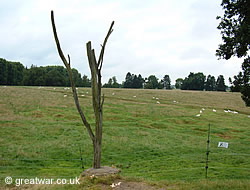
|
The Danger Tree is a petrified tree and the only original tree in this location to survive the 1914-1918 fighting in this location.
The Visitors' Centre
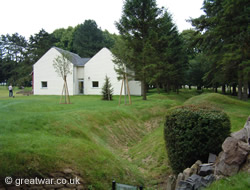
|
For information about the Visitors' Centre, free guided tours and opening hours see our page:
Visitors' Centre in Newfoundland Memorial Park
Queries & Information Contact
For queries regarding opening hours or for any questions about the visitor information at the site, you can contact Veterans Affairs Canada:
Email: beaumonthamel.memorial@vac-acc.gc.ca
Website: www.veterans.gc.ca Beaumont Hamel Newfoundland Park
Telephone: (from Canada) 011 33 3 22 76 70 86; (from Europe) +33 (0) 3 22 76 70 86
Location of the Newfoundland Memorial Park
Latitude N 50° 4' 26 " ; Longitude E 2° 38' 57"
The Newfoundland Memorial Park is situated on the east bank of the Ancre River, on the D73 between Hamel village and Auchonvillers village.
Parking
There is a free car park available for cars and coaches but this is cordoned off outside visiting hours for the Visitors' Centre (see above).
If the car park is closed you can park on the road.
Further Reading

The First Five Hundred: Being a Historical Sketch of the Military Operations of the Royal Newfoundland Regiment in Gallipoli and on the Western Front (Paperback)
by Richard Cramm
Published by Albany, New York 1921. (OCR reprint January 2010). 140 pages. ISBN-10: 1152461125 and ISBN-13: 978-1152461123

Memoirs of a Blue Puttee: The Newfoundland Regiment in World War One (Paperback)
by A J Stacey
Published by DRC Publishers (2002). 190 pages. ISBN-10: 0968420915 and ISBN-13: 978-0968420911

Beaumont Hamel (Battleground Europe) (Paperback)
by Nigel Cave
Published by Pen & Sword Books (April 1994). ISBN-10: 0850523982 and ISBN-13: 978-0850523980

The Spirit of the Troops is Excellent, The 6th (Morayshire) Battalion, Seaforth Highlanders in the Great War 1914-1919
by Derek Bird
The 6th Battalion Seaford Highlanders served in the 51st (Highland Division) and participated in the fight for Beaumont Hamel in November 1916. Published by Birdbrain Books (Nov 2008). ISBN-10: 0956022308 and ISBN-13: 978-0956022301
Related Topics
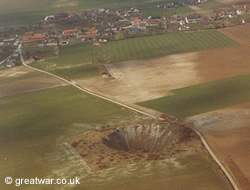
|
Visiting the Somme Battlefields

